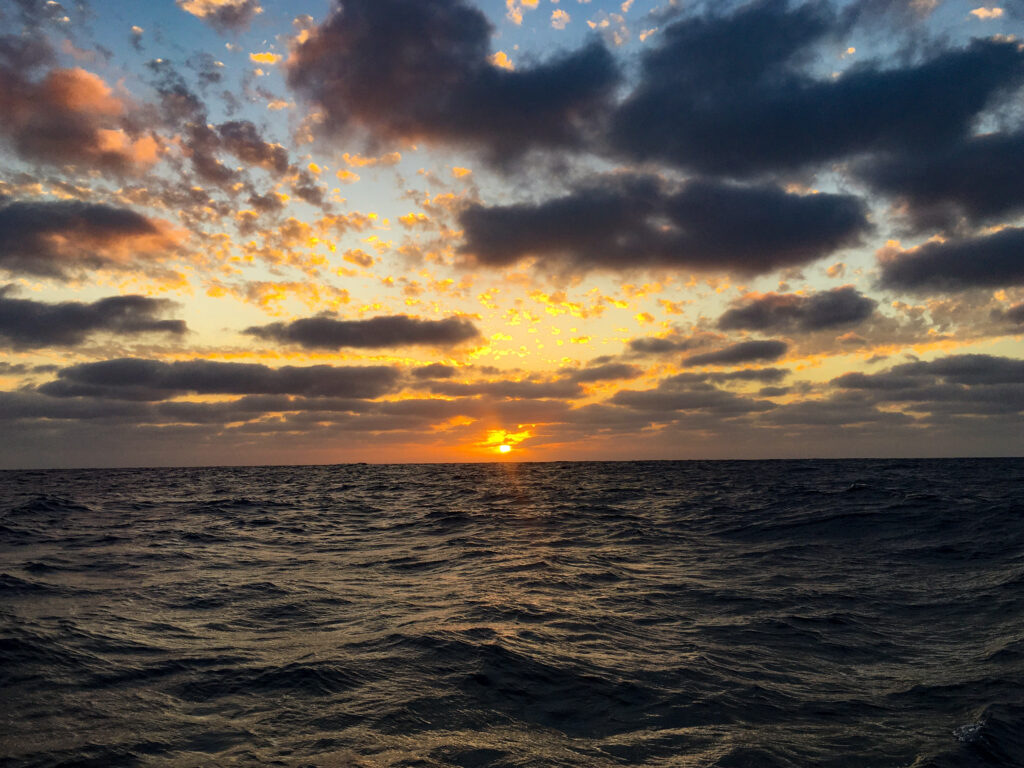With our much-awaited package in hand, we prepared to depart that night for the 60-hour passage across the Sea of Cortez. Given the current weather window, Eitan wanted to leave right away because we would only have wind for about the first half of the trip. We departed La Paz around 8 pm that night. The first 30 hours of the passage were incredibly uncomfortable. Given the wind and swell, the boat was rocking and rolling so much that most activities were impossible, including sleep. We were finally on a solo watch schedule of 3-hours-on and 9-hours-off meaning we each only had one day shift and one night shift. The order of rotation was Abbey, Eitan, Connor, and then me with the 2:00 to 5:00 am/pm timeslot. It was nice to have so much time between shifts but rest did not come easy even though we were all exhausted. During our trip down Baja, I prided myself on not being seasick the entire time and was naïve to think I was immune to nausea. Given that most of our plates had flown out of their cubby and smashed on the wall, we were limited to light snacking as it was.
I was reminded there is no pause button out here. You can’t call it quits in the middle of the ocean and you can’t pull the boat over for the night and stay in a protected anchorage whenever you please. During this time, I thought a lot about the future Pacific Ocean crossing and wondered if I am cut out for it. Could I potentially do this for three weeks? Eitan assures us that the Pacific is named for its placid behavior and calm rolling swells but I still wonder how it would compare to the hours of exhaustion the first day of this crossing had brought. Crossing an ocean seems really easy when you are well-rested and the seas are calm but after hours of not eating or sleeping, I found myself asking “I quit my job to do this?!”.
I know burning diesel defeats the purpose of our chosen form of transportation but I found myself looking forward to the second half of the crossing with little wind and, hopefully, flat water. The night watches were particularly stressful for me as I heard the autopilot cranking below, trying to keep us on course. I counted down every minute of the 3-hour shift and hoped it would be an uneventful evening. On my second night watch, the wind finally calmed down and I was able to enjoy the peace and serenity of being out in the middle of the ocean. The galaxy above was more incredible than I had seen on the previous nights and filled with shooting stars, which I took as a good omen for the rest of the trip. Around the last hour of my watch, I started to hear something hitting the boat followed by flopping on deck, and noticed we had some flying fish land on board. Since we aren’t allowed to leave the cockpit at night alone, I rescued whichever ones came within arm’s reach until I noticed streams of glowing light in the water. The fish were being driven out of the water and onto the boat by a pod of dolphins that were hunting them. With the bioluminescence of the water, the dolphins were only visible by their glowing paths. The dolphins stuck around until it was time for Abbey to relieve my shift and I went to the front of the boat to sit and watch the dolphins light up the water. Simply magical!
With calmer seas, I was finally able to rest and we were all more energetic the following day. Connor set out three fishing lines in hopes of catching something. Suddenly, We heard the sound of line being stripped from the reel and saw a marlin jump in the distance as he was chasing our bait. While everyone else was excited for fresh fish, I was apparently the only one concerned that this potential catch could be bigger than Abbey and we were entirely unprepared to land a fish of this size. Luckily, the marlin didn’t get hooked on the lure after all and we continued on. The rest of the passage was relatively uneventful, just as I had hoped it would be, and on the morning of Day 3, we arrived in beautiful Isla Isabela.
